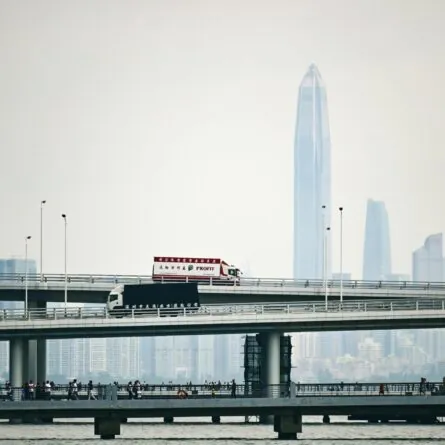
China has an opportunity to ensure its stimulus spending boosts the economy, not emissions.
Written by Linxiao Zhu
On 5 March, in an unprecedented move that broke the country’s fiscally conservative and consumption-averse principles, China raised its fiscal deficit to a new high of 4% with plans to add 11.86 trillion yuan (~$1.64 trillion) in debt in 2025. The fiscal stimulus package, part of an effort to rescue the economy from years of slowdown, aims to boost consumption, recapitalise banks, invest in infrastructure, manufacturing and real estate. While many details are still under wraps, officials have indicated that even more spending is on the table amid growing geopolitical uncertainties.
Decarbonisation, however, continues to take a back seat to pressing economic concerns. In the latest Government Work Report (GWR) which outlines Beijing’s key priorities for the year, boosting consumption was, for the first time, ranked as the top priority – above developing advanced manufacturing. Meanwhile, decarbonisation remained in ninth place, underscoring the government’s ongoing priority of post-Covid economic recovery over emissions reductions.
Under the 14th Five-Year Plan (FYP), China set headline targets to reduce energy/GDP and emissions/GDP intensity by 13.5% and 18% respectively by 2025 from the 2020 benchmark. However, by the end of 2024, these two key binding targets remained off track, with reductions of only 7% and 7.8%.1 The shortfall not only raises questions about China’s ability to meet its 2030 intensity goals but also challenges its “under-commit and over-deliver” climate mantra.
China’s stimulus effort in 2008 offers critical lessons. While the 4 trillion-yuan (~$570 billion at the time) stimulus successfully helped the country navigate the global financial crisis, it led to a decade-long struggle with overcapacity in heavy industries, soaring emissions and severe environmental pollution. To prevent another costly policy correction, it is imperative that energy and climate considerations are integrated into this round of spending.
Leveraging consumption for deeper emissions cuts
Central to Beijing’s consumption-boosting campaign is an equipment trade-in scheme which subsidises the replacement of vehicles, ships, industrial facilities and agricultural machinery with newer, more energy-efficient and lower-emission models. Launched in March 2024, Beijing appropriated 150 billion yuan (~$21 billion) to the programme in 2024 and doubled the amount for 2025 as part of the stimulus. The scheme has already yielded positive results: it saved an estimated 28 mt of standard coal equivalent in energy and reduced CO2 emissions by 73 mt during the nine months of 2024 – over half of China’s targets set for the year.
There remains significant potential to unlock deeper emissions cuts. For example, of the 31.4 million vehicles sold in 2024, only 6.6 million were part of the trade-in programme, with around 60% of those being EVs. Currently, the programme offers subsidies of up to 20,000 yuan ($2,755) for trading in old vehicles and purchasing new EVs – far lower than the $7,500 provided by the US Inflation Reduction Act, which has no trade-in requirement.
Given the severe overcapacity in the EV sector and staggering consumer purchasing power, policymakers should lift the subsidy cap and pivot more subsidies toward EVs over internal-combustion vehicles. There is also room to enhance subsidies to boost broader household consumption, which is much less carbon intensive than boosting the consumption of manufactured equipment alone.
The manufacturing push: an energy consumption wild card
Despite the pivot to consumption, Beijing continues to invest heavily in advanced manufacturing, as outlined in the GWR. A key priority is the application of artificial intelligence (AI) across industries and the development of data centres nationwide.
The energy-intensive industry sector has been the key driver of emissions increases in recent years, offsetting emissions reductions from the rapid deployment of renewable energy.
According to the IEA, industry accounted for 48% of the energy demand growth in 2021-2024 and is expected to contribute to 50% of demand growth in 2024-2027. Meanwhile, electricity demand from data centres is estimated to range from 260-1000 TWh in 2030, a significant increase on the approximately 100 TWh consumed in 2023.
Currently, there are no stringent headline emissions checks on new industrial capacity. China requires only 20% of the energy consumed by new energy-intensive capacity in 2025 to be renewable, with a non-binding, yet-to-be-announced national renewable power consumption target for 2030. Stricter regulations are needed to prevent both existing and new capacity from continuing to rely heavily on coal-fired power.
Way forward
China has an opportunity to ensure its spending stimulates the economy without stimulating emissions. This could be achieved via:
An ambitious nationally determined contribution (NDC) with a strong headline emissions reduction target.
A 15th FYP with a decisive end date on new coal-fired power capacity and detailed sectoral decarbonisation plans.
A stimulus with clearer policy requirements to boost greener consumption and cleaner industrial activities.
With bold, forward-thinking policies China could make every yuan spent count – powering a resilient economy and demonstrating climate leadership in this pivotal year for the Paris Agreement on the road to COP30 in Belém.
Author’s calculation based on annual energy and emissions intensity data released by the National Bureau of Statistics*
